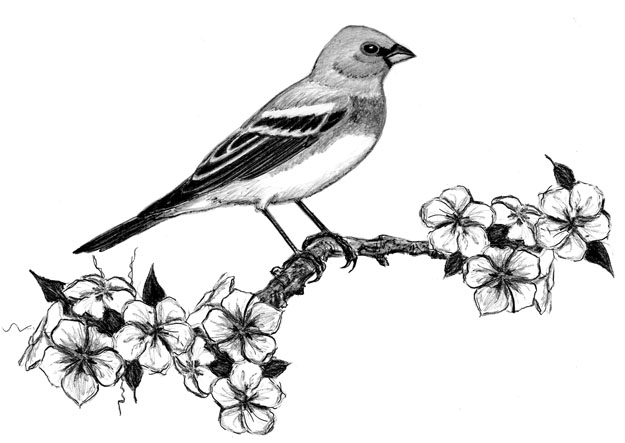
Dear Bird Folks,
I recently saw the rare Lazuli Bunting at the Wellfleet Bay Wildlife Sanctuary. I understand that these buntings normally live out West and that this particular bird is a young male. Could it have born here from parents that had already straggled into this area? Also, if the weather turns very cold, do you think it will survive?
– Dianne A.
It’s pretty exciting, Dianne,
Well, kind of exciting. For anyone who has somehow missed the story, let me fill you in. For the past few weeks a Lazuli (laz-uh-lee) Bunting has been seen eating under the feeders at the Mass. Audubon property in Wellfleet (MA). However, if you haven’t seen this bird yet, you aren’t missing a lot. It’s a small bird, not much larger than a chickadee and it’s kind of dull, about as colorful as a sparrow. It’s also not a rare bird. In fact, Lazuli Buntings are quite common. So what’s the big deal? Well, remember, the people who are getting excited are birders. It doesn’t take much to get those folks excited, especially in the winter. They’ll use any excuse to show off the new binoculars and camera equipment they received for Christmas. Also, this is the first time a Lazuli Bunting has ever been seen on Cape Cod. That’s an important fact because most birders are cheap. If they can somehow see a rare bird locally, without having to travel far, it will save them gas money. That’s really what all the excitement is about.
If you look at a U.S. map you’ll see that the geographical center of the contiguous United States is somewhere around Lebanon, Kansas. (I think a cornstalk marks the spot.) Everything to the left of Lebanon is considered the West and everything to right is the East. Lazuli Buntings are western birds; they hate to go to the right of Lebanon. They are much happier in the part of the country where lost calves are called “dogies” and the deer and the antelope really do play with each other.
The “lazuli” part of Lazuli Bunting’s name refers to the adult male’s striking blue coloring. His plumage is so vivid that even bluebirds are jealous. Anyone who was actually paying attention to what I wrote earlier might be confused right now. How could a bird “as colorful as a sparrow” be striking blue? You see, only the adult males in breeding plumage have this handsome coloring. As you noted, Dianne, the bird in Wellfleet appears to be a young male and has not molted into its signature plumage yet. His few blue feathers are rather spotty, looking like a two-year-old kid who just finished eating blueberry pancakes.
Typically, Lazuli Buntings can be found in and around thickets, brushy areas, chaparral and tumbleweeds, which the birds use as mobile homes. They often feed on the ground, eating a variety of seeds and small insects. When it comes to nesting and raising young, it is the dull-colored female that does most of the work. The male does very little with the kids because he is too busy singing. The male Lazuli Bunting loves to sing and never seems to stop. Even later in the summer when most other birds have had enough with the singing, he still keeps at it. And while any constant singing can be annoying, the male bunting’s sound is even more annoying because he always sings the same song. Research has shown that the male bunting develops a song unique to him, and once he learns it he’ll sing it over and over and over. I feel bad for him. You know how awful it is have a song, say like, “Camptown Races” (doo-da, doo-da) stuck in your head? This poor bird has the same song stuck in his head his whole life and has to sing it all the doo-da day.
So how did this singing, soon-to-be colorful bird of the West find its way to Cape Cod? I have no idea. I don’t think anyone does. Most of the time when a bird turns up outside of its normal range the explanation is either bad weather or a mix-up in the bird’s internal map. I doubt bad weather brought the bird here. Weather seems to have a greater effect on seabirds, or any bird flying over water. Even if storm winds did push this bunting, it could have easily landed and waited for the storm to pass. The internal map mix-up makes more sense to me. Instead of migrating south to Mexico for the winter with the other buntings, this bird became confused and flew east. Over a period of months it continued to travel east, all the time wondering what the heck happened to Mexico. When it finally reached the Atlantic Ocean it gave up and settled for the next best thing to Mexico, bueno viejo Wellfleet.
Your suggestion that this bird may have been born here, the offspring of two previously lost parents, is sweet, Dianne, but not likely. Lost birds rarely travel in pairs. That’s more like the behavior of an older married human couple. Will our cold weather affect it? Probably not. First of all, it hasn’t been very cold this year. Plus, these birds have been found nesting high in the Rockies. I’m sure they’ve had to deal with cold weather before.
Finally, a customer suggested to me that the Lazuli Bunting isn’t really lost, but instead has been conveniently planted on the Audubon property in an effort to gain more admission fees. I told the guy that his theory was ridiculous. Mass. Audubon has indisputable integrity. But I don’t. I love the idea of using rare birds to attract business. Anybody have a California Condor they’d like to rent?